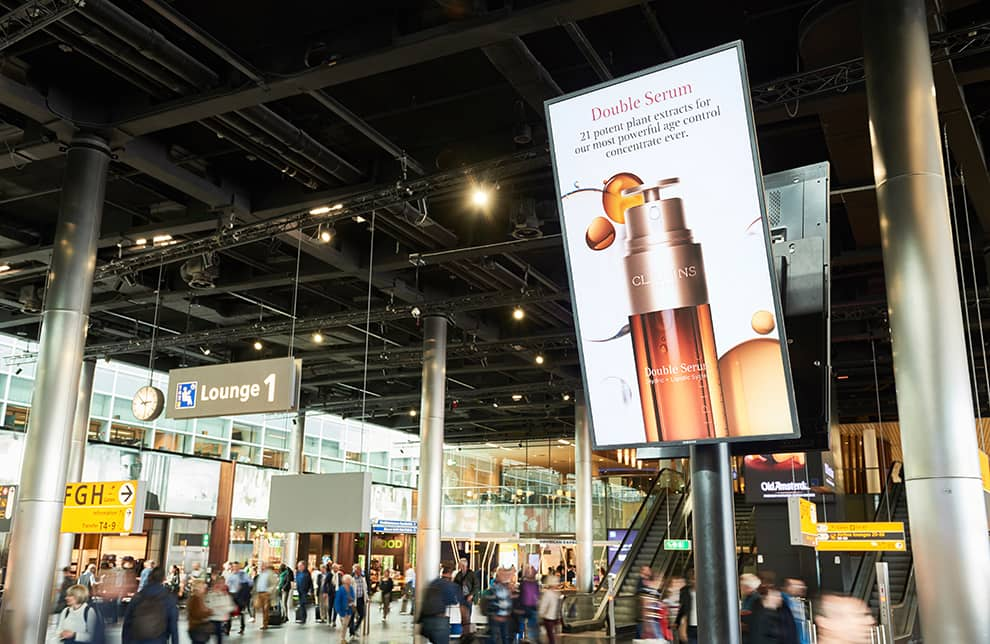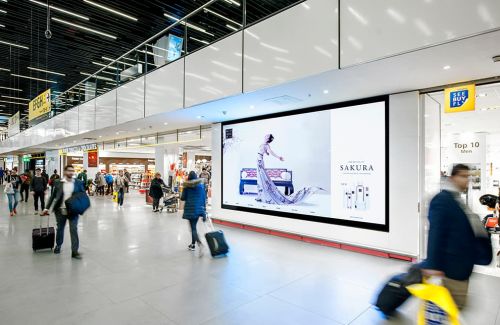Digital Out Of Home:: A landslide in the advert landscape?
We live in the Golden Age of Out-of-Home advertising. Eye-catching adverts in public space were already difficult to ignore. But with the advent of digital/data elements, your target audience simply can’t miss them. No wonder Digital Out-of-Home (DOOH) is growing so quickly. In the United Kingdom, more than 50% of OOH budgets are now being spent on the digital version. So, how can you capture the power of DOOH?

To learn more about the power of DOOH, Timo Beuzekom from Schiphol Media spoke with experts Tobias van Amstel from Signkick, Michael van Kloosterhuis from Traffic Builders digital marketing and Wendy Pouw from industry association IAB Nederland.
Proven mass medium is reborn
From billboards to bus shelters to petrol pump banners: OOH is as old as time itself. But in 2008, the old dog revealed a new trick. Digital turned out to be a game-changer in the field. Now that digital screens have replaced many public space OOH objects, and the screens are being programmatically utilised, the true appeal of the medium is coming to light.
Traditional market goes digital at a rapid pace
More and more advertisers are recognising the value of Digital Out-of-Home, and they’re curious about the opportunities and threats that may arise from the increasing digitisation of traditional outdoor media. IAB Nederland, the independent industry association for digital advertising and marketing innovation, set up a DOOH Task Force in response to the blending of on- and offline marketing in the OOH segment. What’s more, the IAB commissions an annual Ad Spend Study, which investigates the transition from traditional to digital media.
For years, Digital Out-of-Home advertising has been undergoing impressive development in the Netherlands. While the market share in 2016 was only 5%, DOOH spending in 2017 increased by no less than 116%. Growth almost doubled again in 2018. And spend on this progressive form of advertising rose by 90%.
Wendy Pouw, director IAB Nederland
A giant leap forward with programmatic approach
Digital, data-driven, dynamic, detailed and determining: DOOH can be it all. But your adverts must be tailored to the medium, use the correct data and utilise advertising moments programmatically. With MyAdbooker and Broadsign, suppliers like JCDecaux and Schiphol can offer airtime on digital media objects. And thanks to platforms like OutMoove and MobPro, advertisers can purchase very specific airtimes, through operators and media agencies.
In one campaign, for a promotional gift specialist, we aligned our cross-media strategy with the rhythm of entrepreneurs. To capture the attention of this important target audience, we bought space on billboards along motorways. But only when our client’s commercials were on the radio. We also advertised at petrol stations and in sports club canteens, where entrepreneurs often act as sponsors. By showing logos of local clubs on the sports bags and water bottles in our adverts, the potential of these promotional gifts became instantly clear. The result? A 35% increase in tenders from the year before, and 15% more proof requests.
Michael Kloosterhuis, Display Advertising Consultant at Traffic Builders
Put some creativity into context-dependent ads
Of course, you can still use DOOH to get general messages to a wider audience. But do you really want to stand out or attract a specific target group? Then have your creative team brainstorm smart connections with simple, external, non-personal data factors, such as weather, traffic, news or planned events. DOOH offers opportunities to respond to passing consumers’ state of mind, and lends itself perfectly to communication with cheek. In one example, Dutch bank ING used data and DOOH to create personal ads relevant to local customers, and with just the right amount of humour. The ads were personalised based on the customer location, and joked about things like on-going construction projects or inclement weather.
Zoom in for more impact
It may seem counter-intuitive for a mass medium like Out-of-Home, but it turns out that less is more.
In the coming years, we'll likely see it more often: brands that do not (just) use a complete screen network over a long period of time, but (only or also) use a few, specific screens as a micro-medium. By zooming in on time, place, target audience and context, you can increase the chances of consumer action.
Supermarkets are already on board, showing daily specials when people enter the store. And at Schiphol for example, more sunglasses are being sold thanks to smartly placed, adaptive ads in the shopping areas near gates with tropical destinations. The advantage if you start using DOOH now? Consumers still aren’t used to this personal approach. You’re guaranteed to stand out with a relevant, smart and/or funny advert!
Read more
-
Programmatic DOOH: what you can (and can’t) do
Think about how to make it work for your particular brand

-
Programmatic DOOH: how do you get it going?
If you start using it this year, you’ll be among the pioneers
